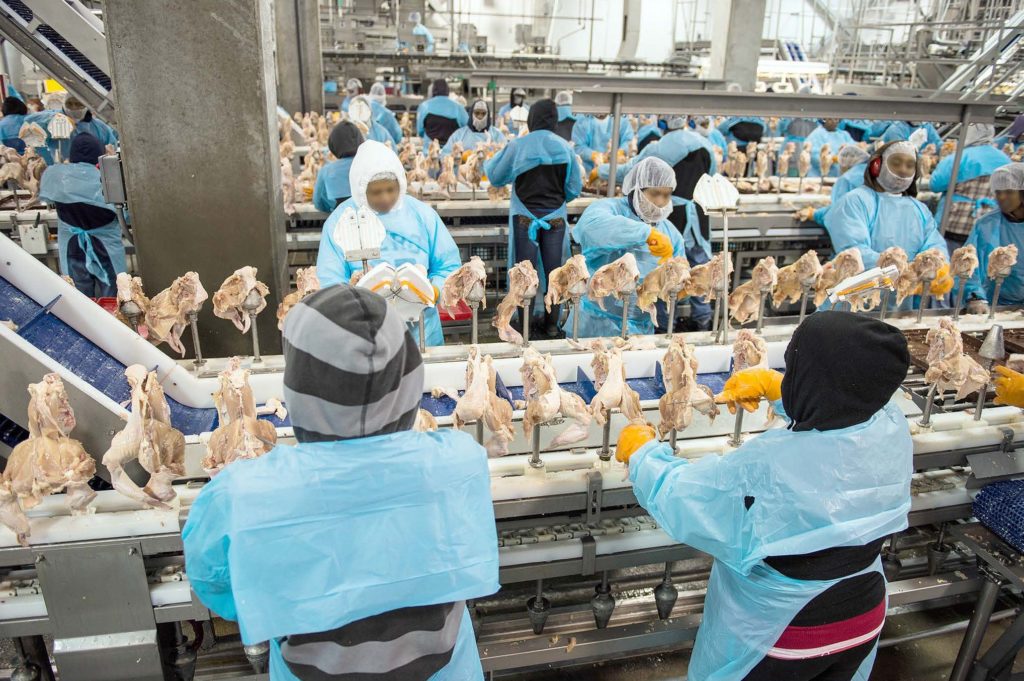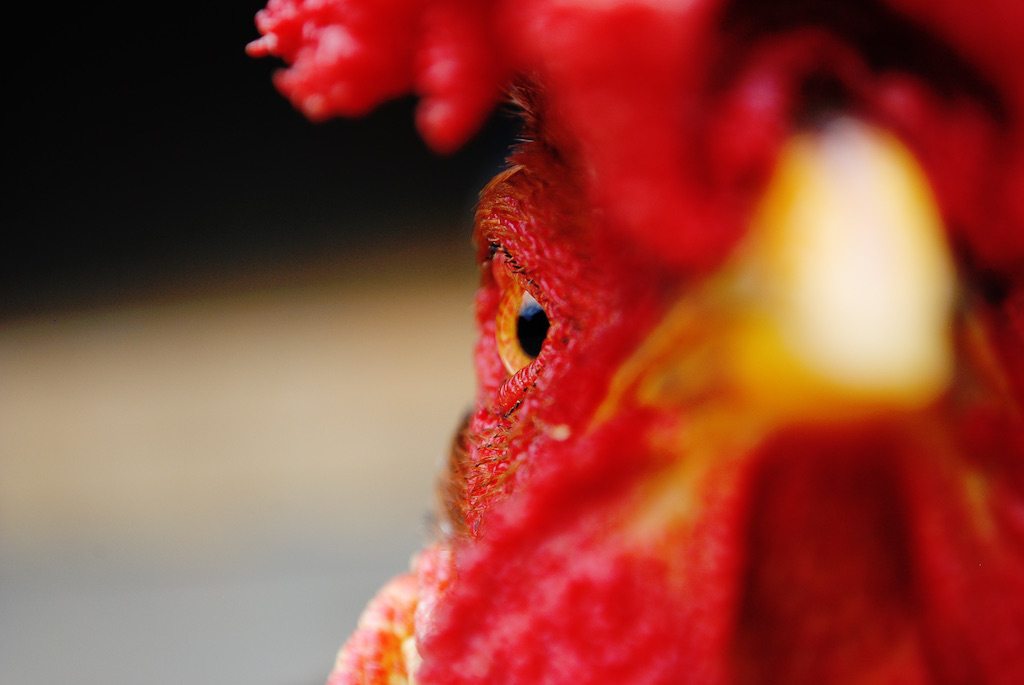Musicians think a lot about BPM—beats per minute—the speed at which a pop song finds its groove, working with varying tempos to bring out different qualities in a song. Tracks that lope along at 90 to 100 BPM tend to feel like rock ballads, while anything at 120 to 130 BPM will have a dancier vibe. Paul McCartney’s steady, 94 BPM foot-taps on the Beatles’ “Blackbird” might lull a child to sleep, while Whitney Houston’s “I Wanna Dance With Somebody” fills the floor at 127 BPM.
But let’s talk for a minute about a different kind of BPM: birds per minute, the term used by the poultry industry to describe the speed at which chickens hurtle through slaughter and evisceration at processing plants. Federal law currently caps line speeds at the vast majority of slaughterhouses at 140 BPM (the ripping tempo, by the way, that’s used in the faster sections of Kanye West’s “All of the Lights”). That means inspectors can be responsible for checking up to 2.33 birds per second, which is still too slow for the industry’s trade association. Earlier this month, the National Chicken Council (NCC) petitioned United States Department of Agriculture (USDA) Secretary Sonny Perdue to waive the line speed limit entirely in a new class of plants, allowing them to operate at any speed “at which they can maintain process control.”
The letter specifically points out that a select few plants are allowed to ramp up speeds to 175 BPM (we’ll get to those a little later), which is getting into the drum ‘n bass category—closer to the berserk cadence of Aphex Twin’s “Vordhosbn.” As you tap your finger to the rhythm of the video below, try to imagine you’re a USDA employee tasked with visually checking chicken carcasses—one bird per beat, nearly 3 birds per second—for disease, fecal contamination, or other defects.
Before we wade too deep into the debate, let’s get some background. In 2014, USDA introduced the New Poultry Inspection Service program (NPIS), a voluntary new standard that allows poultry processors to streamline their inspection processes. It’s a push towards automation and decreased human oversight that represents a major, potentially paradigm-shifting change in the way poultry slaughter facilities are regulated.
While traditional poultry plants are required to use four USDA Food Service and Inspection Service (FSIS) inspectors on their lines, NPIS-certified plants are required to use only one. NPIS plants pick up the oversight slack by hiring their own staff to monitor the lines, ideally weeding out any problem carcasses before they reach the FSIS inspector visually inspecting each carcass at the end. At the same time, NPIS plants agree to a more intensive spot-checking program. A second, “offline” inspector is required to test for salmonella and campylobacter bacteria at a rate of one carcass per 22,000 processed, or three birds per eight-hour shift; offline inspectors are also required to pull 10 birds off the line every hour to check for fecal material and other issues. That’s a more stringent requirement compared to traditional plants, as non-NPIS facilities need to pull only 20 birds per eight-hour shift.
You might think that’s a basically good deal for the chicken industry: NPIS plants can move closer to self-regulation without any reduction in line speed. But the industry isn’t happy. It argues that the new safety standard is more financially onerous, while also mandating slower line speeds than necessary.
The National Chicken Council is upset, in part, because the NPIS standard was developed during a voluntary 20-plant pilot that allowed lines to run at 175 BPM (the “select few” plants NCC called out in its petition to Secretary Perdue). While those plants will be allowed to continue running their operations at that high speed, other plants that sign onto NPIS will be stuck at 140 BPM, like everyone else in the industry—even though the standard itself was developed at 175 BPM. Though USDA initially proposed that plants adopting the NPIS standard would be able to run at the higher speed BPM, blowback from labor, animal welfare, and environmental groups—as well as current and former FSIS inspectors—caused them to revise the rule during the public comment period, ultimately capping line speeds at 140 BPM.
The NCC now says this situation creates a competitive disparity in the U.S. chicken industry, and that its constituents are holding out on becoming part of the NPIS program until the playing field is leveled. As of now, according to the NCC, only 65 out of more than 200 facilities have have actually signed on to participate in the program.
But the industry isn’t really asking for line speed parity. It’s arguing that line speed limits should be waived entirely, if the U.S. chicken market is going to remain competitive in an increasingly global marketplace. (Plants in other parts of the world, notably Germany and Brazil, are already running their chicken lines at speeds up to 200 BPM). In its petition, NCC wrote that waiving line speed limits would be a big step towards “leveling the playing field within the U.S. chicken industry, eliminating competitive barriers between the U.S. and international chicken producers, [and] removing arbitrary limitations on operational control in establishments.”
Cue the outcry from activist groups that oppose factory farms, which say that faster speeds lower safety standards for both workers and consumers. The environmental advocacy group Food & Water Watch, for instance, has said that NPIS does not meaningfully increase oversight at all. In its view, the NPIS certification already essentially allows plants to self-monitor, and upping line speeds beyond 140 BPM would exacerbate a lack of accountability that is already galling.
“We were concerned about the food safety implications of implementing NPIS and we also believed that USDA did not take into consideration worker safety and animal welfare concerns when making this dramatic change to poultry inspection,” said Wenonah Hauter, executive director of Food & Water Watch, in a release. “The only positive in that final rule was the cap on the line speeds in chicken plants to 140 birds per minute (bpm) instead of increasing them to 175 bpm, as USDA had originally proposed.”
According to quality-control reports that Food & Water Watch obtained through a Freedom of Information Act (FOIA) request (poultry plants are required to report violations detected under NPIS), the spot-checked birds are frequently found to be in pretty rough shape. Many carcasses are still smeared with feces; even more troubling, birds are often found to have their intestines still partially attached, oozing waste and other fluids. Here’s one indicative sample:
“The sixth bird of the ten bird sample contained a piece of intestine that was approximately 1/8″ in length,” reported an inspector working at a Pilgrim’s Pride plant in Alabama. “Fecal material as observed to be at the end of the intestine. The fecal material was approximately 1/16″ in length, green in color, and pasty in consistency.”
The presence of feces, of course, is not a concern just because it’s gross—punctured intestines are often how serious food-borne pathogens begin to spread. But company employees at NPIS plants, according to a government-issued “compliance guideline” manual, have a sprawling list of other defects to look out for, too. While carcasses zip by, staff members must check for tumors, inflamed organs, skin blemishes and other warning signs. Reddish discoloration can signal Septicemia/Toxemia, a disease-causing bacteria that pollutes the blood. A “floppy neck” can be one sign the bird is a “cadaver”—one that died somehow before slaughter, and is not fit for consumption. The NPIS program largely shifts the responsibility for detecting these defects from FSIS officials to company “sorters,” who may not be as impartial (or as well trained) as government food safety professionals. An FSIS inspector will still be spot-checking for quality, but detractors worry that 10 birds an hour—that’s 10 out of up to 8,600 birds, if a line is running at 140 BPH—is not a large enough sample size.
Others have made the case that higher line speeds result in labor concerns. The lines on which chickens are killed and eviscerated are mostly automated, but not fully. Human beings still string live birds up by their their feet, eviscerate them, and then manually cut out defects after slaughter. The USDA says these defects are mostly cosmetic, not a safety issue: “bruises, scabs, or sores … may pose a concern for the marketability of the product, they pose little or no threat to food safety,” the agency wrote in a FAQ on poultry slaughter. But the faster the lines run, the more quickly these workers must move, and the more likely they are to injure themselves. That’s true even on the slower-running “processing line,” where workers chop birds into wings and thighs.
“Each worker will have to work harder,” Deb Berkowitz, who served as chief of staff of the Occupational Health and Safety Administration (OHSA) from 2009 to 2012, tells me. “This is a case where they want to get more out of each worker. That’s the whole point here.”
In August, a diverse coalition of 40 organizations—including The American Public Health Association, Oxfam America, the International Brotherhood of Teamsters, and the NAAC—wrote a letter to Secretary Perdue to oppose any increase in line speed beyond 140 BPM.
“We are deeply concerned that any line speed increase would jeopardize the health and safety of both poultry workers and consumers at large,” they wrote, citing Bureau of Labor Statistics data revealing that poultry plant workers face over seven times the national average of occupational illness and injury. The coalition also referenced two alarming studies from the National Institute for Occupational Safety and Health that found between 37 and 42 percent of workers to have carpal tunnel syndrome.
“Workers stand, shoulder to shoulder, in cramped quarters, amid deafening noise and slippery conditions,” their letter wrote. “They make thousands of forceful cuts a day at break-neck speed, using sharp knives and scissors, with acidic chemicals sprayed over the meat, and onto the skin, and into the eyes, nose and throat of the workers, as the meat moves down the line. A single wrong move could lead to an amputated finger or life-threatening cut. And cumulatively, these repetitive movements cause irreparable damage to the nerves, tendons, and muscles of the workers.”
For its part, the NCC has argued—in a letter responding to OxFam America’s critical report “Lives on the Line”—that chicken industry injuries are on par with other manufacturing industries, and are falling at a faster rate. And USDA, in its final ruling, argues that a move to a more automated NPIS system is better for government workers, since there are fewer of them on hand. Since inspectors “will have infrequent contact with the carcasses, their inspection activities will involve less frequent head and hand motions,” according to the rule. “…FSIS believes the reduction in hand activity under the new inspection system will lead to a reduction in the risk of musculoskeletal disorders for inspection personnel.” It’s an argument we’re likely to hear more often as agriculture becomes increasingly mechanized: fewer people, fewer problems.
No matter what side of the debate you’re on, the industry has a point: It doesn’t really make sense to let a select few plants operate at higher speeds, while the rest of the country is stuck in second gear. But there are already questions about whether processing staff—who are incentivized by their employers to work with speed and efficiency in mind, as well as safety—are able to properly fulfill the duties once performed by more neutral government inspectors under NPIS.
“If this proposal goes through and inspectors are cut, I would not feel safe enough to feed [chicken] to my family,” wrote Rebecca Patlan-Garcia, an FSIS poultry plant inspector, during NPIS’ public comment period in 2012. Unlike government officials, she wrote, company employees are unwilling and often unable to stop the line when they have quality or human health concerns. “If FSIS cut[s] back inspectors to save money, there would be no guarantees that the industry would produce the safe, wholesome product that we enjoy now.”
Since then, the matter’s been settled—the new, more streamlined NPIS standard is available to the companies that want it. That still hasn’t been enough to satisfy the NCC. Their question, now, is whether the poultry processors will be allowed to waive BPM limits entirely.
We’ll see if USDA is willing to dance to the industry’s tune.











